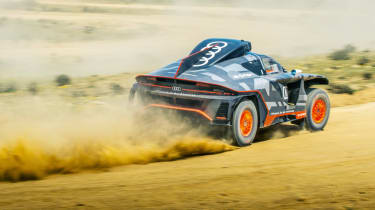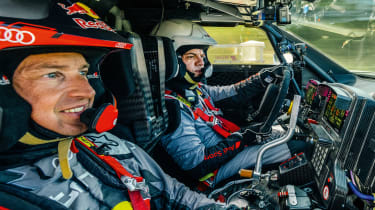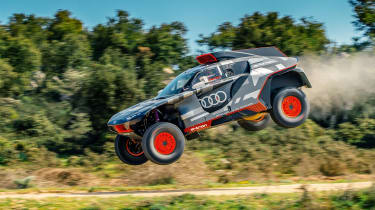Audi RS Q e-tron – hybrid Dakar racer driven
Audi’s monster Dakar desert racer combines electric motors from Formula E with a detuned DTM petrol engine in one extraordinary package. Hold on tight as we put it through its paces
It must be some time in the late ’80s. ‘The Ride of the Valkyries’ is ringing out of a cathode-ray TV pushed into the corner of the living room at my parents’ house. I’m pretty much mesmerised as cars float over the desert floor, motorbikes elegantly glide from one ascent to the next and, as the music reaches its zenith, a huge racing truck flies from atop a colossal dune in slow motion, sand cascading from the treads of its tyres. It’s like the world has been whipped from beneath its wheels and a wide-eyed young Bovingdon feels like the rug has been pulled from everything I know, too. What is this magnificence unfolding in front of me?
The footage is a promo piece on Eurosport for the upcoming Paris-Dakar and it is balletic, exotic and deeply enthralling. Over the next couple of weeks I’m obsessed: consuming the daily highlights packages voraciously, reeling at the thought of a 10,000-kilometre race, falling under the spell of the giant support trucks that race alongside the cars and seem just about as fast. There are tragic deaths, tales of bandits, crashes that leave the landscape littered with debris, and drivers and riders who look broken, elated, dazed and, mostly, out of their minds. The Paris-Dakar seemed like a fable that Marco Polo would dream up. Rally Raid. Even the name had a fairytale quality to it.
More reviews
Group tests
- Alpine A290 v Alpine A110 – how much DNA do they really share?
- Ariel Atom 4R v Caterham Seven ‘evo25’: power-to-weight heroes go head-to-head
- Caterham Super Seven 600 v Super Seven 2000
- Levante v T1
- Corvette Stingray v Porsche Cayman GTS v Audi R8 RWD
- Great Ferrari hypercars driven: 288 GTO, F40, F50 and Enzo head-to-head
- Hardcore Ferrari V8 specials go head-to-head
- Lamborghini Aventador Ultimae v Lamborghini Countach
- Lotus Emira v Morgan Plus Four – four-cylinder Brits go head-to-head
- Toyota GR86 v BBR Mazda MX-5: supercharged drop-top battles sports coupe
In-depth reviews
- Abarth 600e 2025 review – Italy gives the Alpine A290 something to worry about
- Alpine A110 review – distinctive, lightweight and unforgettable to drive
- Audi R8 (2015 - 2024) review – the ultimate soft-focus supercar
- Bentley Continental R Mulliner: review, history and specs
- BMW 5-series review – is this still Munich’s anchor model?
- BMW 1-series review – Munich’s Audi A3 rival gains focus
Long term tests
- Abarth 695C Turismo Fast Fleet test – 10,000 miles in the Italian hot hatch
- Alfa Romeo Giulia Veloce Fast Fleet test – 7000 miles in the sharp Italian saloon
- Alpina B10: end of term report
- Alpina B10
- Ford Mustang GT
- Ford Mustang GT
- Ford Mustang GT
- Land Rover Defender 110 Fast Fleet test – 9000 miles in the go-anywhere SUV
- Maserati Ghibli Trofeo Fast Fleet test – 4000 miles in the Ferrari-powered saloon
- Mitsubishi Evo MR 340
Review
- New Aston Martin DBS 770 Ultimate review – 759bhp super-GT driven
- New Bentley Batur 2023 review – can it possibly be worth £1.65m?
- 2023 Chevrolet Corvette C8 Z06 review – the American 911 GT3?
- Kia EV6 GT-Line S prototype review – the EV that shows how it’s done
- BBR Supercharged Mazda MX-5 (ND) 2023 review – tuned 250bhp roadster driven
- MG4 Trophy 2023 review
Reviews
- Abarth 695 75 Anniversario edition 2024 review – a fitting send-off for Abarth’s hot supermini?
- Abarth 500e 2023 review
- AC Cobra 378 Superblower MkIV 2021 review – another V8 Cobra, but with a GM heart this time
- Acura Integra Type S 2024 review – a Honda Civic Type R with added restraint
- Alfa Romeo Giulia 2025 review – get one while you still can
- Alfa Romeo SZ: history, review and specs of an icon
- Alfa Romeo 1750 TBi
- Alpina B3 GT Touring 2025 review – a 190mph alternative to the BMW M3 Touring
> Porsche 919 Hybrid review - driving one of Stuttgart's most successful racers
My love affair with the idea of the Dakar has never ended but, strangely, I’ve never really followed it closely since. Instead, I’ve wanted to hold on to the sense of mystery and myth that shrouds this epic, other-worldly race. Even now, in a time when access to coverage is so much easier, I tend to look on from afar at the Dakar. Like it exists in another universe. Untouchable, unknowable.
Maybe that was better. On a freezing morning, high up in the hills of Sardinia, my world and the world of the Dakar have collided. And it doesn’t sound enticing. At all. And that’s despite the dusty, narrow, bumpy rally stage and the team of engineers and mechanics buzzing around the outrageously proportioned Audi RS Q e‑tron that I will be driving very, very soon. This should be the dream. And it is. Until a serious-looking man from Germany begins his driver briefing.
Mostly it’s the usual stuff. Be cautious at first, build up your pace, don’t crash. But the e‑tron requires new information, too. ‘If there’s a problem with the car and it stops on the stage, stay in the vehicle. Even if the light is green. We will come and assess things and give instructions.’ The e‑tron is an EV. Of sorts. It has a light system to inform driver, co-driver and anybody assisting during a breakdown or in the event of a crash when the car is safe to touch. He continues, now in an even more forceful tone. ‘Unless it’s on fire. If there’s fire get out immediately. Inhaling the smoke from a battery fire will create life-long health issues.’ There’s a nervous laugh from the assembled journalists. The German man is not laughing. Or smiling.
I’ll admit that the safety briefing knocks me from my stride just a bit. Although, to be honest, there was something vaguely surreal about this trip and this vehicle from the outset. The RS Q e‑tron didn’t win the Dakar. This isn’t a media victory lap. Audi’s all-star driver line-up of Carlos Sainz (three-time Dakar winner), Stéphane Peterhansel (six-time winner on two wheels, eight-time winner on four) and blisteringly quick Dakar rookie Mattias Ekstrom (two-time DTM champion, World Rallycross champion) won four legs of the 2022 event, which is now held in Saudi Arabia. However, despite flashes of real speed, Ekstrom just squeaked into the top ten to finish ninth overall, Sainz was 12th and Peterhansel way down in 59th. This is not the sort of result Audi would usually crow about. Audi wins. Always.
So what’s going on here? The clue is in the name – e‑tron. Can you imagine the ingenuity, the effort and the engineering mastery required to complete the Dakar with an EV? What a story! This is why Audi has brought us to Sardinia and is happy to let one of its extremely precious, spectacularly tough and simply huge RS Q e‑trons out to play in a giant sand pit. As I roll out from under the technical area and towards the course, the thump of my heart is drowned out by the piercing, high-pitched electric motors located on each axle. The steering is freakishly light and conveys zero information about what those huge tyres are biting into, but I squeeze the throttle anyway. About halfway through its arc, an internal combustion engine booms to life behind me – and sits steady at 6000rpm no matter what my right foot does.
So, this is the curious case of an ‘e‑tron’ fitted with a 2-litre, turbocharged four-cylinder engine from Audi’s previous DTM programme. A heinously complex vehicle developed in partnership with Q Motorsport, a Rally Raid specialist outfit run by Sven Quandt. Yes, that’s Quandt as in the family who own the majority stake in BMW. I told you it was a curious case…
In essence, that repurposed DTM engine is a range-extender. Power is reduced from over 650bhp to around 270bhp. It powers an electric motor that in turn charges a 52 kWh battery, which then powers an electric motor on each axle. The motors themselves are taken from Audi’s Formula E programme. The fact that the internal combustion engine has no direct connection to the wheels is why it runs at steady revs. The battery could provide up to 671bhp but due to regulations the output is limited to 387bhp and top speed pegged at 112mph. There’s no centre differential but instead a ‘virtual’ diff that alters the torque split depending on conditions and driver preference (Sainz likes a more rearward bias than Peterhansel). The RS Q e‑tron carries 300 litres of fuel as well as that 370kg battery pack around.
Inside, once you’ve threaded yourself through the complex roll-cage, there’s a strange mix of modern race car and elevated, almost SUV-style driving position. A kind of GT3-spec Porsche Cayenne, if you like. The seats, the sense of claustrophobia, the bracing and various control panels are pure race car. However, the RS Q has additional screens for the co-driver and although the steering wheel features various buttons and acts as a control centre as you might expect, the size of it and its roundness are a world away from the wheel in a modern circuit racer. Oh, and there’s a hydraulic handbrake just where you’d want it. Maybe a Q8 WRC is a more accurate description.
The chassis is tubular steel, reinforced with carbonfibre panels and tear-resistant Zylon in places, too. The battery is located beneath the seat and under-leg area of driver and co-driver and benefits from a multi-material protection cell designed to withstand jumps, rock intrusion and all the stuff that only the Dakar serves up. The underside, for example, is shrouded in a 54mm thick structure consisting of a layer of carbonfibre for intrusion protection, absorption foam for dissipating the energy of rock strikes or extreme landings, and finally an aluminium plate to handle the initial impacts. The whole piece can be swapped in the bivouac when necessary, but even under the duress of the Dakar none of the vehicles required such maintenance. Today’s tight, technical course holds no such fears. Maybe that’s why Peterhansel’s co-driver, Edouard Boulanger, seems so content in the passenger seat. ‘You’ll understand the car soon enough,’ he chirps over the headset. ‘It’s very simple to drive.’
He’s absolutely right. The RS Q e‑tron requires so little physical effort to hustle, it soaks up wickedly testing terrain, and despite weighing well over two tons you never get the sense that its momentum could get away from you. There’s just an incredible sense of freedom. It really is as if everything I know is wrong. Rather than connecting you to the surface, Audi’s Dakar machine almost seems to remove it from the equation. Just concentrate on your line, on nailing those braking points and getting on the power as early as possible. The clever virtual diff and the stupefying Reiger remote reservoir dampers will do the rest. From the outside it’s all churning dust trails, extreme lean angles and dramatic oversteer. It looks heroic yet feels oddly calm. The Dakar is about endurance and consistency. Speed is a factor too, of course, but the RS Q e‑tron’s raw pace is a by-product of its drivability.
Peterhansel had told me how easy the car is to drive, but it’s quite amazing to feel so comfortable so quickly. ‘The way the electric motors deliver their power is so predictable,’ he said. ‘This creates confidence and then… precision. No gears to worry about, no lag, just where you’re going and the very best line to get there. We are too heavy, but otherwise the car is fantastic.’ The minimum weight is 2000kg for this class but the e‑tron is more like 2250kg without the crew aboard. You feel the weight in the way the nose dives under braking and the roll and pronounced squat as the corners open out. But whilst the sheer mass is tangible and affects the e‑tron’s gait, there’s always a sense that the weight is being manipulated and controlled. Everything is checked at a certain point, just when you need and demand immediate response. It really is oddly precise and wonderfully fluid.
Seat-time in the RS Q e‑tron is predictably brief and most of it is spent trying to master the hydraulic handbrake and the way the car distributes its power through the tight, technical turns. The balance is closer to, say, an Impreza than something like a GT-R. Try to drive it without the handbrake and it tends to wash into understeer and then, should you have the space, drive into oversteer when you commit to the throttle. So, it’s best to arrive already pointing at the apex (a quick tug of the handbrake does the trick) and then flatten the accelerator to haul the car straight. I maybe get two corners absolutely nailed in the entire run. But they’ll live long in the memory.
Against expectations, almost none of my time is spent thinking about the odd hybrid drivetrain. The noise is dominated by electric whine to such an extent that the internal combustion engine becomes a distant, background thrum. The cynic in me thinks the e‑tron label is a bit of a misnomer, marketing rather than engineering-led. However, it doesn’t lessen the achievement of making three Formula E motors and a DTM engine work in the most inhospitable conditions, nor reduce the fuel saved over a race distance. The RS Q e‑tron is a hugely capable, deeply intriguing and slightly absurd monster of a Rally Raid machine. The glorious, bizarre, hypnotic and plain brilliant Dakar rally deserves nothing less.
Audi RS Q e-tron Dakar specs
| Powertrain | Three electric motors, plus 2-litre petrol engine (generator) |
| Power | 387bhp (Dakar spec) |
| Weight | 2250kg |
| Power-to-weight | 176bhp/ton |
| 0-62mph | <4.5sec |
| Top speed | 112mph (limited) |
This story was first featured in evo issue 302.








